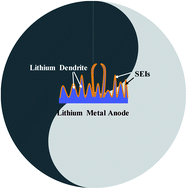Investigating lithium metal anodes with nonaqueous electrolytes for safe and high-performance batteries
Abstract
Lithium metal batteries are promising candidates for meeting the increasing demand for next-generation energy storage devices with high energy density; however, the problems of lithium dendrites and unstable solid electrolyte interphases (SEIs) for lithium anodes with nonaqueous electrolytes severely hinder their practical applications. The first step to address these issues is to establish a better understanding about these phenomena. In this review, we first discuss the formation processes and related mechanisms of dendritic lithium and SEIs, which are revealed and supported by the specially designed setups combined with various advanced characterization techniques including operando scanning transmission electron microscopy (STEM) and deduced theoretical models. Because of the high sensitivity of lithium metal anodes to the ambient environment, their microscopic characterization remained challenging until the development of noninvasive cryogenic electron microscopy. Then, we present the real-state atomic structures and chemical compositions of lithium dendrites and SEIs by cryogenic transmission electron microscopy (cryo-TEM) coupled with electron energy loss spectroscopy (EELS). Based on these fundamental insights, various strategies including electrolyte engineering, construction of artificial SEI layers, and use of three-dimensional hosts for lithium, introduced to solve the lithium anode problems, are summarized. Finally, the future directions and opportunities regarding lithium anode research are discussed.

- This article is part of the themed collection: Sustainable Energy and Fuels Recent Review Articles


 Please wait while we load your content...
Please wait while we load your content...